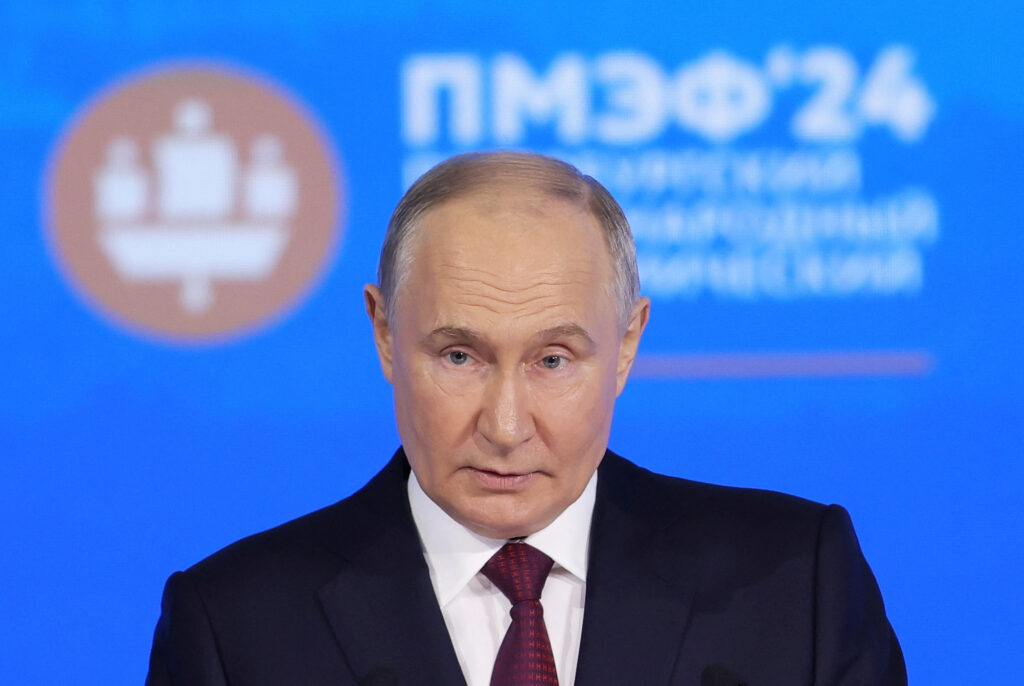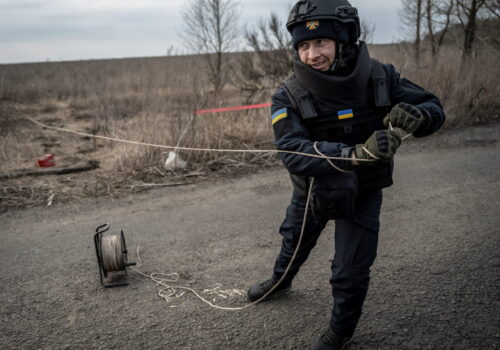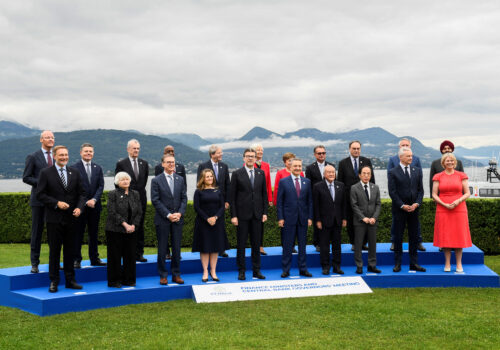Seven ways to reboot G7 sanctions on Russia
At the St. Petersburg International Economic Forum on June 7, Russian President Vladimir Putin was defiant about the Russian economy. “Despite all the obstacles we are facing and the illegitimate sanctions imposed against us,” he declared, “Russia remains one of the key participants in global trade and is rapidly expanding the new logistics and geography of cooperation.” This is especially the case with non-Western countries, he indicated. Putin glossed over the difficulties, but the Russian economy has thus far been able to sustain his war of aggression in Ukraine.
At this dangerous moment, with air assaults continuing and a renewed land offensive likely in Ukraine, both sides of the Atlantic need to put their backs into support for Kyiv, whose success in its war of survival is critical to transatlantic security and remains possible. The most important part of that work is for the United States and European countries to provide more and better weapons with fewer caveats—a process that is already underway. But it also means exerting more economic pressure on Russia’s wartime economy.
Sanctions and other forms of economic pressure alone are not going to force Putin to abandon his war objectives. But they can continue to weaken the Russian economy, lower Russian income, complicate production, and intensify the distortion of a rapidly militarized economy with an increasingly starved civilian sector. The Russian economy, like the Soviet economy, has little natural resilience. Nor does it allow space for entrepreneurship on a large scale. Under sustained pressure and extreme military spending, it will be prone to decay, like its Soviet predecessor. Group of Seven (G7) countries imposed sanctions against Russia after its initial invasion in 2014 and much stronger measures after Russia launched its full-scale war in 2022. Both sets of sanctions have had an impact. But as recent Russian economic statistics show, the impact of these efforts is plateauing as Russia gets better at evading and mitigating them. Sanctions are a dynamic game, and the United States and its G7 partners need to be as agile in addressing Russia’s responses to existing sanctions as Russia has been in adapting to the sanctions themselves.
“Sanctions are like antibiotics: Repeat usage builds up resistance,” Deputy National Security Advisor Daleep Singh explained in remarks on May 28. The necessary and appropriate response, then, is to intensify them to produce the desired effect. Happily, there are viable options to intensify the economic hit on Russia. None is without some risk or complication—options that promise all gain and no pain don’t actually exist. But the United States and the European Union (EU) should follow and choke off the money, show they mean it when it comes to enforcement, and hold sanctions evaders accountable.
Steps to do this could include:
1. Give the Russian oil price cap more teeth
Oil remains Russia’s number one export earner. The Russian oil price cap sought to limit the price of Russian oil sold on world markets to sixty dollars per barrel while not limiting the quantity of sales. The price cap was designed to reduce Russian income without spiking world oil prices, which would have happened if sanctions took Russian oil off the markets. And it worked, especially in the first year, lowering Russian revenues from oil sales by about 40 percent in the first nine months of 2023. The enforcement occurred through banning Western services, such as insurance and shipping, to oil shipments above the price cap.
Over the past year, however, Russia has adapted to the sanctions, procuring a “ghost fleet” of tankers to transport oil at prices above the price cap and offering its own insurance and other services to buyers. This ghost fleet has enabled Russia to demand its buyers pay prices closer to market value—and above price cap prices—because buyers cannot cite the price cap as an impediment to their paying higher prices.
It is time for the G7 to adapt the price cap accordingly. The G7 should back the price cap with the threat of secondary sanctions on those companies engaged in or supporting sales of Russian oil above the price cap by, for example, purchasing Russian oil above the price cap or shipping it. These secondary sanctions could be announced with a grace period of, for example, four months. During this time, current customers of Russia that are buying above-cap oil could rework their purchasing agreements with Russian suppliers, and US and EU enforcers could gather material on potential targets should they not do so. It’s also time to curtail the ability of banks, wherever they are based, to support the sale of Russian oil above the price cap. This can be done by narrowing the scope of licenses intended to facilitate financing for oil trade.
Any steps to check Russian revenue through oil sales would have to be gamed out to lower the risk of unintended consequences, such as a spike in prices. The Biden administration has been sensitive to any such steps, going so far as to press the Ukrainians not to strike at Russian oil refineries. This was an ill-considered admonition and was badly received by the Ukrainians, who rightly regard Russian refineries as legitimate military targets and have conducted effective attacks on them.
But the principle that informed the initial price cap still applies: As long as the price cap is significantly above Russia’s cost of production, Russia will have an incentive to keep up exports and will suffer a major loss of revenue if it does not. Russia’s cost of production can be estimated in various ways, but generally is regarded at well under sixty dollars per barrel. The risk of spiking world oil prices by more aggressively enforcing a cap on Russian oil exports thus seems acceptable.
2. Cut off Russia’s energy future
Russia has also been adapting to the sanctions by developing new capacities to help export oil and gas that don’t rely on its traditional pipeline network. This includes liquefied natural gas (LNG), where the Biden administration late last year sanctioned Russia’s Arctic LNG 2 project as a particular target. While Russia is the world’s fourth-largest LNG exporter, global production (and US production in particular) is rising. LNG supply shortages seem unlikely in the near term.
Russian officials have also discussed building new pipelines in the country’s east, particularly to China. US sanctions should push back on these efforts to develop new energy export avenues. Measures could include forcing all LNG service companies out of the sector, using the threat of secondary sanctions, and imposing additional sanctions on new export flows. As with increases in oil sector sanctions, these might have to be phased in and accompanied by licenses to avoid unintended consequences—for example, with Japan’s interest in LNG kept in mind.
3. Push Western firms to crack down on diversion of their products to Russia
Many Western companies have fully withdrawn from the Russian market, and even those that remain have generally adopted programs to comply with Western sanctions. However, reporting continues to find Western component parts pervasive across Russia’s military machinery: One recent study found that 95 percent of the non-Russian components in Russian weapons recovered in Ukraine were from Western firms, with only 4 percent from Chinese firms. Many of these Western components were likely produced in China and other manufacturing hubs and then disappeared into a network of shadowy middlemen.
After the 9/11 terrorist attacks, the US government pushed global banks to overhaul the way they complied with sanctions, and the banks generally developed an extensive infrastructure to spot and stop terrorist and other rogue money moving through the financial system. The United States and its partners should undertake a similar effort with the manufacturing and tech sectors, working collaboratively to strengthen compliance and reduce the diversion of Western-made components flowing to Russia. Through warnings and public enforcement actions, such as civil and criminal penalties that make examples of selected companies that show flagrant irresponsibility, the United States and Europe could put pressure on firms to take seriously the “Know Your Customer” (and “Your Customer’s Customer”) principle.
4. Drop the hammer on third-country evaders
Reports abound of exports of banned technologies to Russia through third countries, including through Georgia, Central Asian countries, and Turkey. US officials have been traveling widely and urging greater cooperation, and the United States has for some time sanctioned third-country evaders. Beyond getting Western companies to strengthen their export controls compliance protocols, the United States should increase pressure on countries that serve as platforms for re-exports to Russia, including an aggressive campaign of secondary sanctions on firms that re-export prohibited goods to Russia.
5. Consider a shift to “embargo-minus” rather than “targeted sanctions-plus”
Since the initial Russian invasion in 2014, the United States and Europe have gradually imposed financial sanctions on Russia’s big state banks and some selected private banks, along with a large number of sectoral sanctions and sanctions on Russian companies. This creates a complex sanctions regime where a lot of trade is banned but a lot of other trade remains allowed, leaving gray areas and loopholes for Russia to exploit and complicating enforcement.
The United States and Europe should consider imposing a general embargo on both trade and financial transactions with Russia, except for defined categories of white-listed trade, such as medicine, permitted energy, and other transactions. Such a system—phased in with grace periods and perhaps starting with a general financial embargo—would have to be flexible enough to account for unanticipated problems by issuing supplemental licenses.
6. Face the China challenge
While apparently not directly sending weapons to Russia, China has emerged as Russia’s greatest economic backer since its full-scale invasion of Ukraine, providing general economic support and dual-use equipment and technology to support Rusia’s war effort. These efforts have weakened the impact of—and could undermine—US and European sanctions. Aware of this, the Biden administration has imposed sanctions on smaller Chinese companies engaged in sanctions violations, hoping for a change in Chinese policy but to little apparent avail. During his trip to Beijing in late April, US Secretary of State Antony Blinken reportedly pressed his Chinese interlocutors to back off their economic support for Russia, and the administration may hope that a frank warning will result in China changing course.
If not, the United States should take action, such as imposing sanctions on a larger Chinese bank or company involved in supporting Russia’s war machine. Chinese financial transactions with Russia are likely happening outside the reach of US sanctions, meaning outside of the US dollar and US financial system. Therefore, these sanctions would initially serve more as a messaging tool than a mechanism to immediately turn off the transactions.
But messaging is important, especially when dealing with China. Sanctions targeting a large Chinese financial institution or significant company facilitating material support to Russia would lead other countries and companies to de-risk from these sanctioned entities to reduce their sanctions exposure. It would mean US secondary sanctions in China. Such steps risk Chinese retaliation or unintended consequences. But a sanctions carve-out that allows China to back up Russia’s military machine, which is what a lack of action effectively amounts to, would pose a bigger risk: that of failure of US and European support for Ukraine and a message that the West is not serious about its own policy.
7. Take Russia’s money to pay for Russia’s war
In a bold move immediately after the full-scale invasion, the G7 immobilized around $300 billion of Russian sovereign assets. It has since debated what to do with the funds and has been slow to get beyond general agreement that they will remain immobilized. Many in the United States have advocated seizing all the immobilized funds and using them for Ukraine (the passage of the REPO Act gives the US legal backing to do so with the funds in its jurisdiction, which is reportedly at least five billion dollars). The EU, where the vast bulk of the Russian assets are located (in Belgium), had limited itself to using the interest on the immobilized Russian principal for Ukraine. While a welcome step, that interest comes to around three billion dollars per year, an inadequate amount given the scale of Ukraine’s needs in the face of Russia’s ongoing war.
The G7 now seems to be closing in on a compromise proposal to take the interest on the Russian assets for twenty years rather than just one year, a proposal that could provide a pot of $53 billion. Those funds could be used as collateral for a loan or grant to Ukraine from the United States or a group of willing countries. Meanwhile, efforts to capture agreement on using the entire principal would continue.
That seems to be a smart compromise that provides one way to have Russia rather than European or US taxpayers pay to help Ukraine. The upcoming G7 summit in Italy would be the time and place to reach agreement. That will not be easy: Some Europeans seem stuck in a mode of thinking that has not yet internalized Russia’s war of aggression against Ukraine and its ongoing aggression against other European countries through disinformation, assassination, and sabotage.
Seizing sovereign assets is a big step. But the G7 crossed the line of absolute immunity for sovereign assets when it immobilized the Russia’s assets more than two years ago. While other countries, such as China and Saudi Arabia, may have hated that step and may be privately warning of retaliation should Europe or the United States go further and take Russian assets or proceeds, they have not pulled funds out of US, European, or UK financial markets. The G7 needs to see through what it began in February 2022 and find a way to use Russian funds to pay for Russia’s war of aggression and national extermination against Ukraine.
Neither these nor any serious economic steps against Russia are risk-free or simple; if they were, they would have been introduced already. Each will require resources to identify targets, anticipate potential risks, and enforce. Manufacturers won’t like the scrutiny or demands that they monitor their products’ ultimate destinations. Third countries will not appreciate the pressure to cut down on diversion of exports to Russia. The United States and allied governments should consider their choices not as alternatives to a zero-risk ideal but against the backdrop of the considerable stakes and their own repeated and accurate statements of how important it is to help Ukraine defeat Russia in this war.
Daniel Fried is the Weiser Family distinguished fellow at the Atlantic Council. His last position in the US government was as sanctions coordinator at the Department of State. Peter Harrell, a former State Department and National Security Council senior director, contributed to this article, for which the author gives thanks.
Further reading
Thu, Sep 8, 2022
Russia Sanctions Database
Econographics By
The Atlantic Council’s Russia Sanctions Database tracks the level of coordination among Western allies in sanctioning Russian entities, individuals, vessels, and aircraft, and shows where gaps still remain.
Fri, Jun 7, 2024
Reconstructing Ukraine at war: The journey to prosperity starts now
Report By John E. Herbst, Olga Khakova, Charles Lichfield
Rebuilding the Ukrainian economy after Russia’s full-scale invasion will be a monumental task. Reconstruction can’t wait for peace and must be a well-coordinated, inclusive process.
Sat, May 25, 2024
Experts react: What to know about the latest G7 ‘progress’ on using blocked Russian assets to aid Ukraine
New Atlanticist By Atlantic Council experts
Group of Seven (G7) finance ministers just met in Stresa, Italy, to discuss what to do with blocked Russian assets. Atlantic Council experts follow the money.
Image: Russian President Vladimir Putin delivers a speech at a plenary session of the St. Petersburg International Economic Forum (SPIEF) in Saint Petersburg, Russia June 7, 2024. REUTERS/Anton Vaganov/Pool




